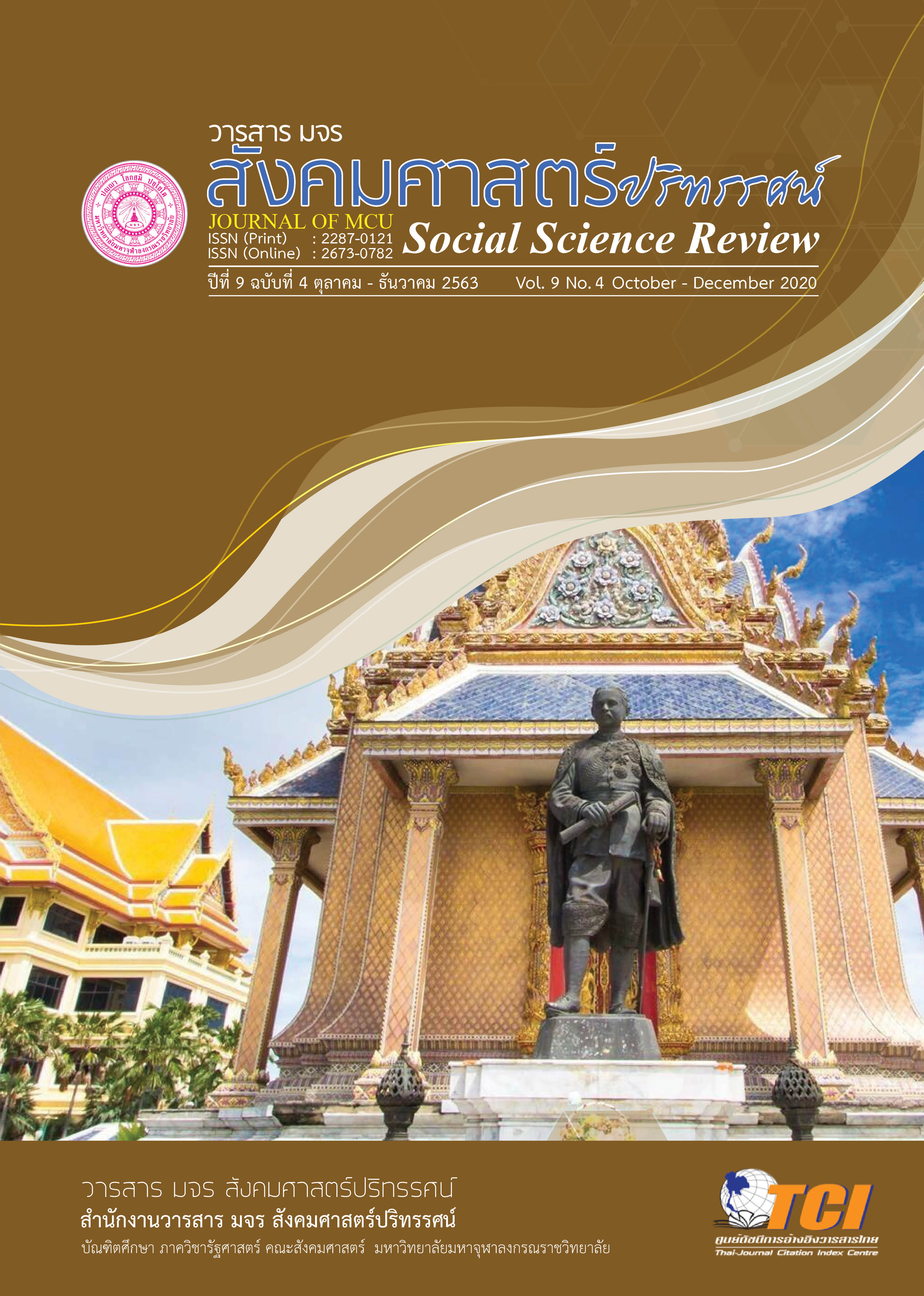“ผี”ท้องถิ่นกับการทำให้เป็นพื้นที่ศักดิ์สิทธิ์ในวัดทางศาสนาสู่การขับเคลื่อนเศรษฐกิจชุมชน : กรณีศึกษาวัดเจดีย์ (ไอ้ไข่) อำเภอสิชล จังหวัดนครศรีธรรมราช
คำสำคัญ:
ผี, ศักดิ์สิทธิ์, เศรษฐกิจชุมชน, วัดเจดีย์ (ไอ้ไข่)บทคัดย่อ
บทความนี้มีวัตถุประสงค์เพื่อศึกษาพัฒนาการของความเชื่อต่อไอ้ไข่ วัดเจดีย์ เป็นการศึกษาเรื่องความเชื่อสู่พัฒนาการขับเคลื่อนเศรษฐกิจชุมชนใช้วิธีการศึกษาจากเอกสาร การสังเกตแบบมีส่วนร่วมในพื้นที่จริง การสัมภาษณ์ และเขียนเป็นความเรียงในแบบบทความวิชาการ ผลการศึกษาพบว่า ไอ้ไข่เป็นผีที่มีพัฒนาการทางสังคมและประวัติศาสตร์ที่พัฒนาจากผีท้องถิ่นไปเป็นผีผู้ปกปักษ์สากล ได้รับความเคารพนับถือและเป็นที่ศรัทธาในวงกว้าง โดยมีผลเชิงประจักษ์เป็นเครื่องสักการบูชา เป็นเครื่องตอบแทนต่อความสำเร็จจากการบนบานร้องขอ และในขณะเดียวกันจากความสำเร็จนั้นทำให้ไอ้ไข่ วัดเจดีย์ จังหวัดนครศรีธรรมราช เป็นที่นิยม ศรัทธา และการร้องขอ อ้อนวอน ด้วยเครื่องบูชา สิ่งใช้ เป็นการขับเคลื่อนเศรษฐกิจชุมชน ตั้งแต่การค้าขายเครื่องสักการบูชา แก้บน เช่น ประทัด ปืนทหาร ชุดทหาร ไก่ปูนปั้น เครื่องแก้บน และการก่อสร้าง การจ้างงาน การท่องเที่ยวและอาชีพอื่น ๆ ทำให้รายได้เงินหมุนเวียนผ่านเศรษฐกิจชุมชนภายในวัด และจังหวัดนครศรีธรรมราชด้วย
เอกสารอ้างอิง
กิตตินันท์ เครือแพทย์ และพิม เดอะ ยง. (2561). การธำรงอัตลักษณ์ทางวัฒนธรรมของศาสนาพุทธนิกายมหายานในมิติของศาลเจ้าจีน กรณีศึกษา อำเภอเมืองภูเก็ต จังหวัดภูเก็ต. วารสารวิเทศศึกษา, 8(2), 109-144.
กิติ แก่นจำปี. (2525). ความเชื่อเรื่องผีปู่แสะย่าแสะ. ศึกษาศาสตร์สาร, (ตุลาคม 2524-กันยายน 2525), 121-133.
จินตนา ณ ระยอง. (2539). พระกับสังคมไทยในปัจจุบัน ศึกษากรณีของหลวงพ่อคูณ ปริสุทฺโธ. กรุงเทพฯ : สำนักวิจัยสถาบันบัณฑิตพัฒนบริหารศาสตร์.
เจษฎา นิลสงวนเดชะ. (2562). มอง “สังคมชาวจีนภาคใต้ของไทย” ผ่านพระราชหัตถเลขา พระบาทสมเด็จพระจุลจอมเกล้าเจ้าอยู่หัวคราวเสด็จประพาส แหลมมลายู ร.ศ. 109. วารสารมนุษยศาสตร์และสังคมศาสตร์, 10(1), 178-215.
ฉลอง เจยาคม. (2548). พล.ต.ต.ขุนพันธรักษ์ราชเดช. กรุงเทพฯ: ร่มฟ้าสยาม.
ช่อง-ส่อง-ผี. (2563). ส่องบุญ LIVE EP.10 I วัดเจดีย์ (วัดไอ้ไข่) นครศรีธรรมราช (16 ส.ค.62). สืบค้น 24 กุมภาพันธ์ 2563, จาก https://www.youtube.com/watch?v=epasnzjD1No.
ทิพย์วิมล พูลสุข และคณะ. (2561). วัดเจดีย์ (ไอ้ไข่) ในฐานะ “พื้นที่ศักดิ์สิทธิ์” ในบริบทการท่องเที่ยว. ใน มหาวิทยาลัยราชภัฏสงขลา. การประชุมวิชาการด้านมนุษยศาสตร์ และสังคมศาสตร์ระดับชาติ ครั้งที่ 1 “มนุษย์ศาสตร์และสังคมศาสตร์ พลังปัญญาเพื่อการพัฒนาที่ยังยืน วันที่ 20-21 สิงหาคม 2561 ณ หอประชุมเฉลิมพระเกียรติ 80 พรรษา. สืบค้น 20 สิงหาคม 2562, จาก http://human.skru.ac.th/husoconference/indexx.php
ธนเดช ต่อศรี และคณะ. (2560). ความหมายและการดำรงอยู่ของความเชื่อเรื่อง “ผีปอบ” ในบริบทสังคมไทย. วารสารวิจัยและพัฒนา :ฉบับมนุษยศาสตร์และสังคมศาสตร์ มหาวิทยาลัยราชภัฏสวนสุนันทา, 9(ฉบับพิเศษ), 152-167.
ธวัลรัตน์ พรหมวิเศษ. (2562). ตำนาน ไอ้ไข่วัดเจดีย์ กับกระบวนการทำให้ศักดิ์สิทธิ์. วารสาร รูสมิแล คณะมนุษยศาสตร์และสังคมศาสตร์ มหาวิทยาลัยสงขลา นครินทร์ วิทยาเขตปัตตานี, 40(1), 35-54.
บุญยิ่ง ประทุม. (2562). พุทธ : ไสย์ ไอ้ไข่วัดเจดีย์กับกระบวนการกลายเป็นสินค้า. วารสารวิชาการสังคมมนุษย์ มหาวิทยาลัยราชภัฎนครศรีธรรมราช, 9(2), 1-18.
ปฐม-ภัทรา นิคมานนท์. (2547). หลวงปู่แหวน สุจิณฺโณ วัดดอยแม่ปั๋ง อำเภอพร้าว จังหวัดเชียงใหม่. กรุงเทพฯ : บริษัท พี.เอำเภอลีฟวิ่ง จำกัด.
พณิดา เอี่ยมสุวรรณ. (2542). ความสำคัญทางเศรษฐกิจของเมืองนครศรีธรรมราช พ.ศ. 2125 ถึง 2419 (วิทยานิพนธ์อักษรศาสตรมหาบัณฑิต สาขาวิชาประวัติศาสตร์เอเชียตะวันออกเฉียงใต้). กรุงเทพฯ: มหาวิทยาลัยศิลปากร.
มาลา คำจันทร์. (2544). เล่าเรื่องผีล้านนา. กรุงเทพฯ: มติชน.
วิชุดา ปานกลาง. (2539). การวิเคราะห์การถ่ายทอดความหมายเรื่อง "ผี" ในภาพยนตร์ไทยเรื่อง "แม่นาคพระโขนง" พ.ศ.2521-2532. กรุงเทพฯ: จุฬาลงกรณ์มหาวิทยาลัย.
ศิรินธร รัตน์เจริญขจร. (2538). ลัทธิพิธีเสด็จพ่อ ร.5: ระบบความเชื่อของชนชั้นกลางในกรุงเทพฯ กรณีศึกษาลานพระบรมรูปทรงม้า เขตดุสิต กรุงเทพฯ (สารนิพนธ์ศิลปศาสตรบัณฑิต สาขาวิชามานุษยวิทยา). กรุงเทพฯ: มหาวิทยาลัยศิลปากร.
สิทธิพงษ์ บุญทอง และคณะ. (2561). วัดเจดีย์ไอ้ไข่: พื้นที่ของการนิยามความหมาย. ใน มหาวิทยาลัยหาดใหญ่. การประชุมหาดใหญ่วิชาการระดับชาติและนานาชาติ ครั้งที่ 9 : The 9th Hatyai National and International Conference คณะบริหารธุรกิจ มหาวิทยาลัยหาดใหญ่. สืบค้น 1 สิงหาคม 2562, จาก http://www.hu.ac.th/conference/conference2018/
สิทธิพงษ์ บุญทอง. (2561). วัดเจดีย์ไอ้ไข่: การประกอบสร้างให้กลายเป็นพื้นที่ศักดิ์สิทธิ์ภายใต้วิกฤตความทันสมัย (วิทยานิพนธ์ปริญญาศิลปศาสตรมหาบัณฑิต สาขาพัฒนามนุษย์และสังคม). สงขลา: มหาวิทยาลัยสงขลานครินทร์.
สุวิทย์ มาประสงค์. (2559). วัดพะโคะกับการสร้างความหมายพื้นที่ของรัฐบรรณาการสู่การสวมทับทางวัฒนธรรมบนวีรบุรุษท้องถิ่น: กรณีหลวงพ่อทวดเหยียบน้ำทะเลจืด. วารสารรูสมิแล คณะมนุษยศาสตร์และสังคมศาสตร์ มหาวิทยาลัยสงขลานครินทร์ วิทยาเขตปัตตานี, 37(1), 6-37.
อนันตศักดิ์ พลแก้วเกษ. (2562). การศึกษาตัวบทและบทบาทของผีปู่ตา อำเภอเสลภูมิ จังหวัดร้อยเอ็ด. วารสารวิชาการธรรมทรรศน์, 19(4), 1-11.
อนุชสรา เรืองมาก. (2559). ขอได้ไหว้รับ: ไอ้ไข่ วัดเจดีย์. วารสารอาศรมวัฒนธรรมวลัยลักษณ์ สำนักวิชาศิลปะศาสตร์ มหาวิทยาลัยวลัยลักษณ์, 16(1), 28-54.
อาสา คำภา. (2555). ปู่แสะย่าแสะกับประเพณีเลี้ยงผีเมืองเชียงใหม่. วารสารเทคโนโลยีสุรนารี, 6(2), 99-122.
Baeq, D. S. (2010). Neak Ta Spirits: Belief and Practices in Cambodian Folk Religion. Research Paper : Trinity Evangelical Divinity School. Retrieved March 20, 2020, from https://www.academia.edu/40262486/NEAK_TA_SPIRITS_BELIEF_AND_PRACTICES_IN_CAMBODIAN_FOLK_RELIGION
Ravangban, P. (2015). Nat and Nat Kadaw: The Existence of the Local Cult in Myanmar Transition. Chiang Mai: International Conference on Burma/Myanmar Studies Burma/Myanmar in Transition: Connectivity, Changes and Challenges. University Academic Service Centre (UNISERV), Chiang Mai University, Thailand.
Reynolew, C. J. (2019). Power Protection and Magic in Thailand. Australia : Australian National University Press.
ดาวน์โหลด
เผยแพร่แล้ว
รูปแบบการอ้างอิง
ฉบับ
ประเภทบทความ
สัญญาอนุญาต
ลิขสิทธิ์ (c) 2020 วารสาร มจร สังคมศาสตร์ปริทรรศน์

อนุญาตภายใต้เงื่อนไข Creative Commons Attribution-NonCommercial-NoDerivatives 4.0 International License.
เพื่อให้เป็นไปตามกฎหมายลิขสิทธิ์ ผู้นิพนธ์ทุกท่านต้องลงลายมือชื่อในแบบฟอร์มใบมอบลิขสิทธิ์บทความให้แก่วารสารฯ พร้อมกับบทความต้นฉบับที่ได้แก้ไขครั้งสุดท้าย นอกจากนี้ ผู้นิพนธ์ทุกท่านต้องยืนยันว่าบทความต้นฉบับที่ส่งมาตีพิมพ์นั้น ได้ส่งมาตีพิมพ์เฉพาะในวารสาร มจร สังคมศาสตร์ปริทรรศน์ เพียงแห่งเดียวเท่านั้น หากมีการใช้ภาพหรือตารางหรือเนื้อหาอื่นๆ ของผู้นิพนธ์อื่นที่ปรากฏในสิ่งตีพิมพ์อื่นมาแล้ว ผู้นิพนธ์ต้องขออนุญาตเจ้าของลิขสิทธิ์ก่อน พร้อมทั้งแสดงหนังสือที่ได้รับการยินยอมต่อบรรณาธิการ ก่อนที่บทความจะได้รับการตีพิมพ์ หากไม่เป็นไปตามข้อกำหนดเบื้องต้น ทางวารสารจะถอดบทความของท่านออกโดยไม่มีข้อยกเว้นใดๆ ทั้งสิ้น





